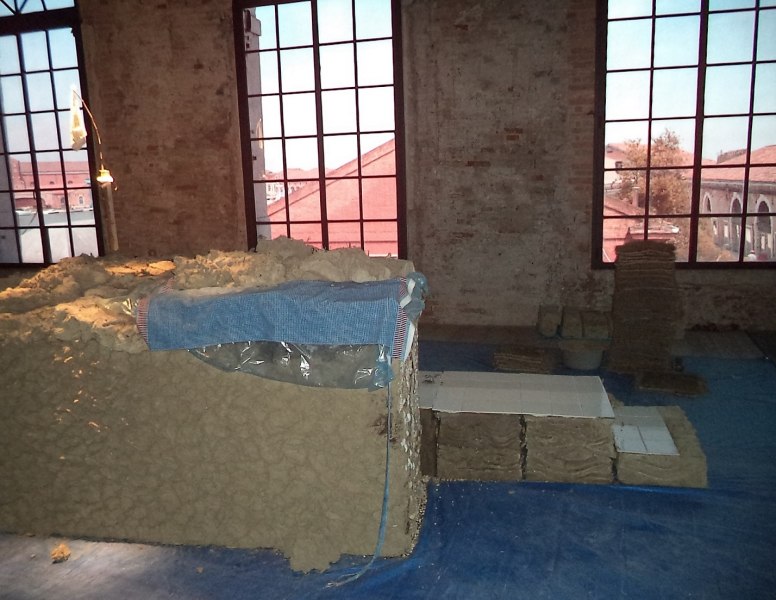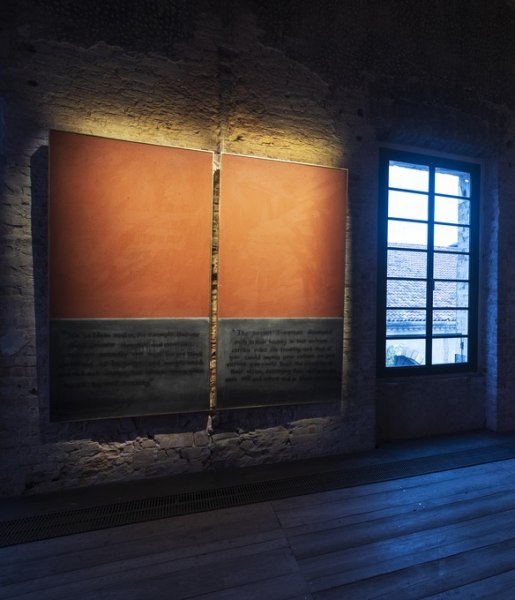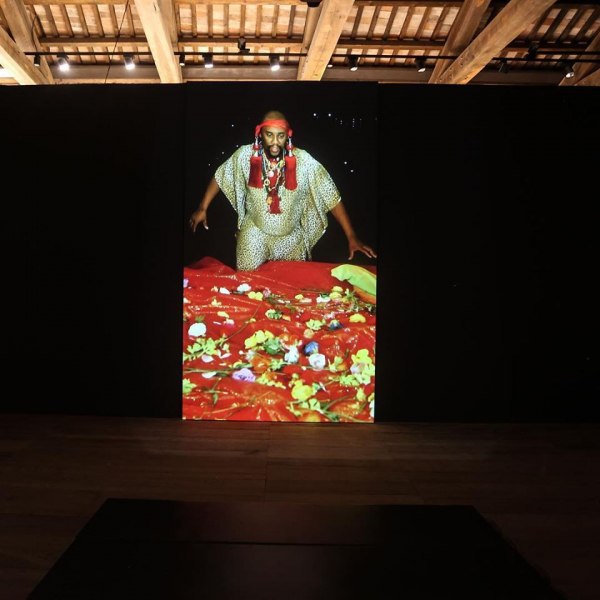Alla Biennale di Venezia 2019, è visitabile l’interessante Padiglione Nazionale del Sudafrica, che porta in mostra un terzetto d’artiste: Dineo Seshee Bopape, Mawande Ka Zenzile e Tracey Rose. I curatori hanno scelto il titolo The stronger we become, tramite cui una “sovversione” dell’intimità consentirebbe la “resilienza” sul disincanto. L’idealismo piace per la sicurezza di volerlo rispecchiare all’esteriorità che progredisca. Invece, chi protesta resiste al dubbio di non poter cambiare manco “una virgola”. Il suo rispecchiarsi vivendo rimarrà fermo al “disincanto” dell’animo. Si cercherà forse di nobilitare la resilienza, con la dignità? Se un idealista esalterà la democrazia del progresso, questo sarà “sovvertibile” tramite l’intimizzazione, e sino a rispecchiare la mera “ombra” del vitalismo? Sappiamo che il Sudafrica subì sia il colonialismo espropriante, sia il razzismo segregante. Quelli furono istituzionalizzati da una Gran Bretagna paradossalmente democratica. S’immagini che l’animismo indigeno abbia concorso ad “ombreggiare” la resilienza. Dal canto suo, l’arte contesterebbe con tutta la “maturità” delle innovazioni. E’ il livello positivo delle frammentazioni. L’originalità dell’artista “esalta” l’intimizzazione d’una comunità. In Sudafrica c’è ancora il rischio che le varie etnie rinuncino a socializzare. Ma l’artista usa la frammentarietà (degli elementi materiali contro il concettualismo quotidiano) per idealizzare unicamente una “bandiera bianca” dell’innocenza. Egli è originale, e quindi “al disincanto” del pragmatismo. La sua resilienza contro i canoni non gli permette di cambiare il mondo materiale, ma almeno d’impegnarlo sotto la “mera ombra” d’una spiritualità. La frammentarietà sociale necessita di farsi nobilitare, perché dal dialogo costruttivo migliora la comunità.
A Venezia, l’artista Dineo Seshee Bopape espone l’installazione dal titolo Its bones the stars. C’è un telo blu, che proverebbe a far “ondeggiare” i mattoni di fango. Però la stazza dell’installazione si percepisce più al tuffo in acqua che all’orbita celeste. Attorno, l’illuminazione sorgerebbe dal “macrocosmo” d’un baccello a faretra. Secondo la Bibbia, Adamo fu plasmato da Dio col fango. L’installazione sovverte il rispecchiamento fra l’erba e la pelle, se il marrone del suolo si fa “umidificare” da un blu celestiale. Ma quanto la zolla avrà la funzione d’una pedana? Materialmente un tuffo nel cielo “cementato” dal blu comporta il disincanto delle stelle, che frammenteranno la propria luce all’ombra dell’articolazione. Coerentemente, immagineremo le foglie a rattoppare il “baccello”. Così l’intimizzazione, prima d’impegnarsi all’autocoscienza d’una luce, alzerebbe la “bandiera bianca” per innocenza d’una crescita. Il Sudafrica ha subito la segregazione razziale, sotto l’opacità d’una democrazia, e come se una faretra lanciasse l’umiliazione del fango. L’installazione dell’artista ci esibisce pure un “arcipelago quasi vulcanico”. E’ il fango in latenza di ribollimento, se la società sudafricana rischia di fossilizzarsi in pochi centri di potere.
Giovanni Pascoli immagina che Dio non posi mai il proprio vincastro, nel moto eterno dell’Universo e pascolando le galassie a “greggi” solo silenziose. Gli uomini sono fatalmente caduchi. Paradossalmente la nostra vita pesa come una pietra, ma si fa trasportare ovunque, dalle “onde” del Destino. Dio lascia che l’uomo cada sulla Terra, a “pascere” i brandelli della Verità (perdutamente da ricercare). L’installazione di Dineo Seshee Bopape si percepisce in via abbastanza lanuginosa, grazie al fango, nel contempo illuminato dal “vincastro” evolutivo d’un “baccello”. Il peso dell’esistenzialismo determina il frastagliamento d’una comunità. C’è il monolito centrale, ma anche un “arcipelago” di tessere. La società si costruisce assegnando a ciascuno un ruolo. Restano le “onde” del destino, chissà quanto da accettare, se il blu del telo appare più conciliante.
Georges Bataille ricorda tutte le stanchezze d’una soggettività che cerca l’estasi. Sempre, la prima non può distinguersi dalla seconda. La soggettività che desidera l’estasi deve immediatamente rinunciare a desiderarla. Solo così potremo evitarne la continua separazione. La soggettività perderà ogni volontà, e quindi stancamente (noiosamente) si lascerà andare. A Georges Bataille, quella pare solo “impantanata” in se stessa. Se qualcuno può sempre chiedersi < Ma io chi sono? >, egli dovrà rispondersi < Sono io >; una conclusione “inutilmente” tautologica, aprendo al paradosso per cui vale l’infinità d’un < Allora chi sono io, mentre mi chiedo chi sono io? >. Georges Bataille scrive che la soggettività “s’impantanerebbe” in se stessa.
A Venezia, l’artista Tracey Rose esibisce la videoinstallazione dal titolo Hard black on cotton. C’è un attore, Denzel Edgar, invitato a distorcere una raccolta di versi liberi, partendo dal latino. Così comanderebbe la lingua, preservando il proprio animismo. Il latino permise il consolidamento d’una civiltà assai pragmatica, in Europa. Nell’immaginario antropologico, i regni africani di contro si fermano alla retorica. Mansa Musa, vissuto in Mali, sarebbe stato talmente invasato dall’oro sino a donarlo per tutti i poveri... Naturalmente, i colonizzatori europei in Africa vollero depredare e basta! Una fotografia ci esibisce Denzel Edgar in rito propiziatorio, intimizzando ogni difficoltà di comunicare con le divinità. Esteticamente, il lusso delle vesti subisce l’ironia d’un “balbettio”. E’ il sovrano che prova inutilmente ad autogiustificarsi nell’intimità. La lingua “tambureggia” per sillabazioni, ma “si lascia andare” alla comprensibilità. I colonizzatori europei purtroppo ingannarono gli indigeni africani. Dunque l’animismo rimase “impantanato” sull’ignoranza scientifica? Ma almeno la letteratura avrebbe potuto preservarsi, in accordo col “balbettio” delle musiche tribali. Tracey Rose opta per una videoinstallazione dove il vitalismo “si lascia andare” all’incomunicabilità. Il popolo africano deve ancora ritrovare se stesso, sotto il colonialismo ipertecnologico. Al “tambureggiare” delle sillabe, si sostituisce il “respiro affannoso” d’un arrabattarsi per vivere.
L’artista Mawande Ka Zenzile ama esporre il dittico a gesso, olio e sterco. La sua raffigurazione a bande o riquadri un po’ ci ricorderà quella di Mark Rothko. Lei arriva dal Sudafrica, e sembra insistere con le tonalità caldamente brune. Inoltre, compaiono le didascalie, incentrate sulla spiritualità d’un incontro con l’alterità. Qualcosa che però i colonizzatori europei scelsero d’imporre a mezzo cultura. Nel quadro dal titolo Ubuza ibhasi ibhaliwe, Mawande Ka Zenzile sostiene che gli indigeni africani avessero tutta la dignità d’una creatività, utile a farli resistere nel proseguimento d’una volontà. Spesso le didascalie dell’artista si percepiscono staccate dalla tela, e più precisamente alla “resurrezione” per l’impronta. L’Africa è una terra largamente aperta al camminamento, escluse le foreste pluviali. Le tribù nomadi hanno una volontà “di ferro”, giusto a citare i toni caldamente bruni dei quadri. L’Africa non è solo da scavare, depredandone le ricchezze per il benessere occidentale. L’artista può inserire la didascalia in un grigio lapidario. In quello, il monito per la cancellazione del segregazionismo non sarà “mascherabile” da qualsivoglia duna.
Recensione estetica per il Padiglione Nazionale del Sudafrica – Biennale di Venezia 2019
HOW WE CAN UPEND A MIRRORING BETWEEN THE GRASS AND THE SKIN,
OR BETWEEN THE SYLLABLE AND THE BREATH,
OR BETWEEN THE HEADSTONE AND THE WALK
At the Venice Biennale 2019, you can visit the interesting South African Pavilion, with the exhibition of three artists: Dineo Seshee Bopape, Mawande Ka Zenzile and Tracey Rose. The curators chose the title The stronger we become, through which a “subversion” of the intimacy would allow a “resilience” on the disenchantment. We like the idealism for our certainty when we want to reflect it on the exteriority which makes progress. Instead, somebody who protests is resisting the doubt about his impossibility to hange even “a comma”. Living, his mirroring will remain fixed at the “disenchantment” of the soul. Maybe will we try to ennoble the resilience, with a dignity? If an idealist will exalt the democracy of the progress, will this one be able to “be upended” through an intimization, and until it will reflect the mere “shadow” of a vitalism? We know that South Africa suffered both the expropriating colonialism, and the segregating racism. Those were institutionalized by a Great Britain paradoxically in democracy. We can imagine that the indigenous animism favoured a “shading” on the resilience. For its part, the art would contest with all the “maturity” of the innovations. That is the positive level of the fragmentations. The originality of an artist “exalts” the intimization of a community. In South Africa the risk that the different ethnicities give up to socialize is still present. However the artist uses the fragmentation (of the material elements against the daily conceptualism) to idealize only a “white flag” of the innocence. He is original, so “at the disenchantment” of the pragmatism. His resilience against the standards does not allow him to change the material world, but at least to engage him under the “mere shadow” of a spirituality. The social fragmentation needs to be ennobled, because, through a constructive dialogue, the community improves.
In Venice, the artist Dineo Seshee Bopape exposes the installation called Its bones the stars. There is a blue cloth, which would try to make the mudbricks “in fluctuation”. However the tonnage of the installation is perceived more for a dip in the water than in the celestial orbit. Around, the illumination would arise from the “macrocosm” of a pod in quiver. According to the Bible, Adam was moulded by God through the mud. The installation upends the mirroring between the grass and the skin, if the brown of the soil allows its “humidification” by a celestial blue. But how much will the clump have the function of a springboard? Materially a dive in the sky “cemented” by the blue determines a disenchantment of the stars, that will fragment the own light at the shadow of an articulation. Coherently, we will imagine the leaves patching the “pod”. So the intimization, before its engagement at the self-awareness of a light, would raise the “white flag” for the innocence of a growth. South Africa suffered the racial segregation, under the opacity of a democracy, and as if a quiver fired with the humiliation of the mud. The installation of the artist shows us also an “archipelago almost volcanic”. That is the mud in latency of a seething, if the society in South Africa risks a fossilization in few power centers.
Giovanni Pascoli imagines that God never puts down the own crook, in the eternal movement of the Universe and grazing the galaxies as “flocks” only silent. The men are fatally passing. Paradoxically our life is heavy like a stone, but allows its transportation everywhere, by the “waves” of the Destiny. God lets the man fall on the Earth, to “graze” the shreds of the Truth (trying perpetually to find it). The installation of Dineo Seshee Bopape is perceived in a way quite fuzzy, through the mud, in the same time illuminated by the evolutionary “crook” of a “pod”. The weight of the existentialism determines the jaggedness of a community. There is the central monolith, but also an “archipelago” of tiles. The society is built when we confer a role to everybody. The “waves” of the destiny remain, who knows how accepted by us, if the blue cloth appears more conciliatory.
Georges Bataille remembers all the tiredness of a subjectivity that looks for the ecstasy. Always, the first element can not be distinguished from the second element. A subjectivity that desires the ecstasy has immediately to give up to the same desire. Only in this way we could avoid its continuous separation. The subjectivity will lose every will, so it tiredly (boringly) will abandon itself. That seems to Georges Bataille only “bogged down” in itself. If somebody can always ask himself < But who I am? >, he will answer < I am me >; a conclusion “uselessly” for a tautology, open to the paradox for which the infinity of < So who I am, while I am asking myself who I am? > is worth. Georges Bataille writes that the subjectivity “would be bogged down” in itself.
In Venice, the artist Tracey Rose shows the video installation called Hard black on cotton. There is an actor, Denzel Edgar, invited to distort a collection of free verses, starting from the Latin. So the language would command, preserving the own animism. The Latin favoured the stabilization of a civilization very pragmatic, in Europe. In the anthropological imaginary, on the other hand the kingdoms in Africa stop on the rhetoric. Mansa Musa, who lived in Mali, would have been so possessed by the gold that he would have offered this one to all the poor men… Of course, the European colonizers in Africa wanted only to despoil! A photography shows Denzel Edgar during a propitiatory rite, where every difficulty in communicating with the gods is in intimization. Aesthetically, the luxury of the clothes suffers the irony of a “stutter”. That is the king that uselessly tries to reach a self-justification in the intimacy. The language “drums” for syllabication, but “abandoning itself” to a comprehensibility. The European colonizers unfortunately deceived the African indigenous. So did the animism remain “bogged down” in the scientific ignorance? But at least the literature could preserve itself, in accordance with a “stutter” of the tribal music. Tracey Rose opts for a video installation where the vitalism “abandons itself” to the incommunicability. The African population still has not rediscovered itself, under an ipertechnologic colonialism. The “drumming” syllables is replaced by the “shortness of breath”, when we are fumbling for our life.
Artist Mawande Ka Zenzile loves exposing a diptych in chalk, oil and dung. Her representation in stripes or squares will a bit remember us the same for Mark Rothko. She comes from South Africa, and seems to persist with the tones warmly dark brown. In addition, the captions appear, based on the meeting with the alterity. Something that however the European colonizers chose to impose through the culture. In the picture called Ubuza ibhasi ibhaliwe, Mawande Ka Zenzile says that the African indigenous had all the dignity of a creativity, useful for them to resist in the continuation of a will. Often the captions of the artist are perceived detached from the canvas, and more precisely at a “resurrection” for a track. Africa is a land largely open to the walking, except for the pluvial forests. The nomadic tribes have an “iron” will, rightly to mention the tones warmly dark brown of the pictures. Africa is not only for dig, despoiling its prosperity for the occidental well-being. The artist can insert the caption inside a lapidary grey. In this one, a monition about the cancellation of the segregation will not be “masked” by whatever dune.
Aesthetics review for the National Pavilion of South Africa – Venice Biennale 2019






